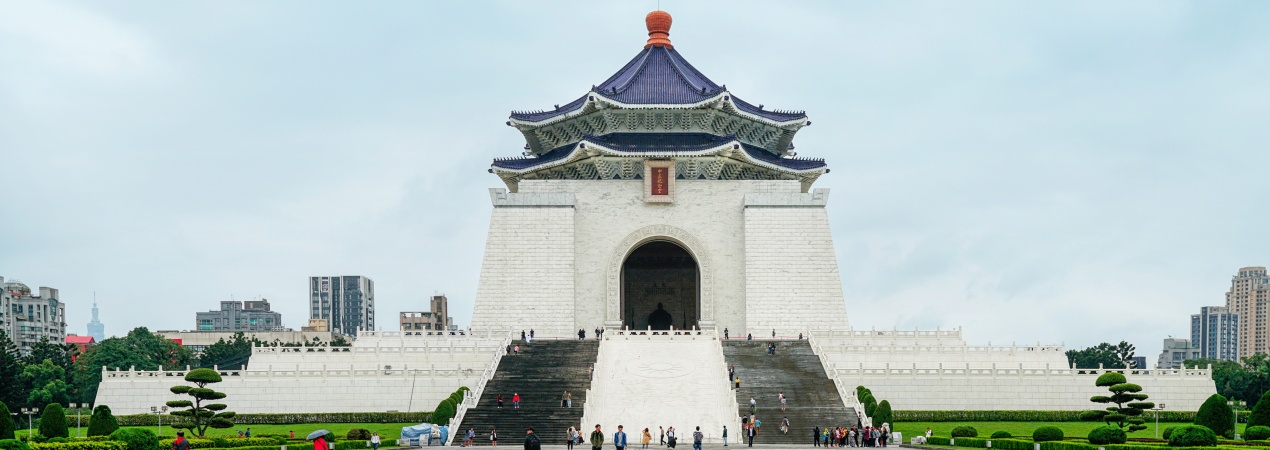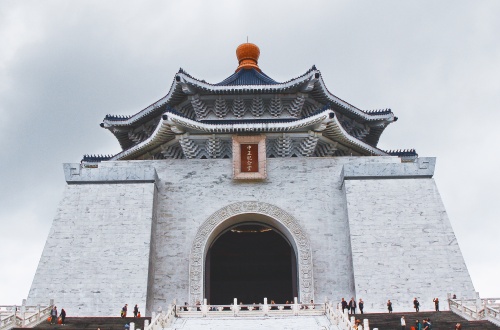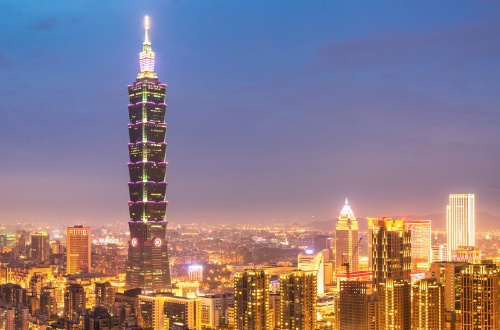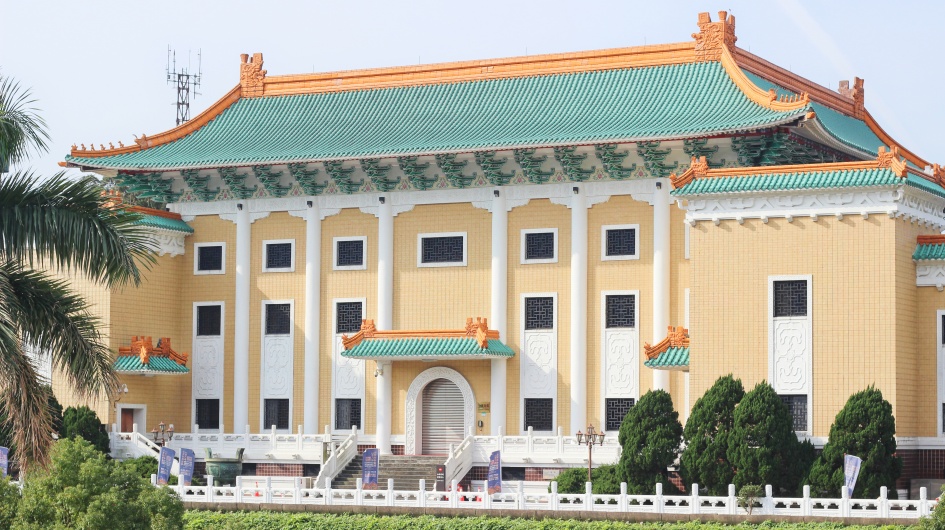Chiang Kai-shek Memorial Hall

Chiang Kai-shek Memorial Hall is in the center of Taipei City, Taiwan Province, China. It was built to remember Chiang Kai-shek, with Hangzhou South Road, Zhongshan South Road, Aiguo East Road and Xinyi Road around it. It covers 75,000 square meters. The Memorial Hall's design takes ideas from two places: the roof of Beijing's Temple of Heaven and the shape of Egyptian pyramids. It's a Chinese palace-style building. The whole building uses blue and white colors, and these colors stand for freedom and equality.
- Chinese name:中正纪念堂 Zhōng Zhèng Jì Niàn Táng
- Recommended Duration: 1-2 hours
- Entrance Fee: Free
- Opening Hours: 9:00-18:00 (Closed on Lunar New Year's Eve, Lunar New Year's Day, February 28 Peace Memorial Day)
- Best time to visit: All year-round
- Address: Surrounded by Hangzhou South Road, Zhongshan South Road, Aiguo East Road and Xinyi Road, Taipei City, Taiwan, China
-
How to get there:
By Metro: Take Metro Xindian Line or Nanshijiao Line to Chiang Kai-shek Memorial Hall Station, then walk to reach
By Bus: Take buses 15, 18, 20, 22, 37, 204, 208, etc. to Chiang Kai-shek Memorial Hall Station or Nanmen Market Station, then walk to reach
Highlights of Chiang Kai-shek Memorial Hall
Hourly Guard Mounting Ceremony
 Hourly Guard Mounting Ceremony
Hourly Guard Mounting CeremonyThe hourly guard mounting ceremony is the most iconic dynamic attraction at Chiang Kai-shek Memorial Hall. It takes place on the hour every day, and the last ceremony at 17:00 (before the hall closes) is more popular among visitors because it includes the flag-lowering part. Ten minutes before the ceremony starts, staff will put up a warning line. The whole process lasts about 10-15 minutes. A 5-person team—made up of 3 incoming guards and 2 on-duty guards—carries out the handover. Their movements are both solemn and performative: slow-motion goose-stepping, precise hand gestures when handing over guns, and careful adjustment of military hats and badges. Every step follows strict rules. After the handover, the guard team marches out of the memorial hall in neat formation and goes to the center of the square to perform the flag-lowering. Music plays as the flag is slowly lowered, and finally, the flag is folded and put away. The whole process is solemn and respectful.
Main Building of the Memorial Hall
 Main Building of the Memorial Hall
Main Building of the Memorial HallThe Main Building is the core of Chiang Kai-shek Memorial Hall. It mixes different architectural styles and symbolic meanings, so it's the best part to see when you're looking at static views. This 70-meter-tall building stands on a three-tiered base. There are 89 granite steps in front of it—they stand for Chiang Kai-shek's 89 years of life. The emblem in the middle of the steps uses traditional palace rules, which makes it feel more solemn. The roof has an octagonal pyramidal shape with glazed tiles. It gets ideas from Beijing's Temple of Heaven and adds elements from Guangzhou's Sun Yat-sen Memorial Hall. This design stands for the "Eight Virtues" and the traditional idea of "harmony between man and nature." Blue glazed tiles and white walls go together here, and this matches specific historical symbols.
The Two Halls (Theatre and Concert Hall)
 Concert Hall
Concert HallOn both sides of the Central Cultural Plaza stand the Theatre and Concert Hall. They're together called "the Two Halls" and are Taiwan's top places for cultural and artistic shows. The Theatre has a Ming and Qing-style gable and hip roof, looking like the Hall of Supreme Harmony in Beijing's Forbidden City. Inside, 4 tiers of seats hold 1,498 people. The orchestra pit can fit a 70-person orchestra to play live music. On the 3rd floor, the "Black Box" experimental theater works well for small shows with 179 to 242 audience members. The Concert Hall's design comes from the Ming and Qing gable and hip roof, using the style of the Forbidden City's Hall of Preserving Harmony. Its special double-tiered gable and hip roof is easy to notice. Inside, 3 tiers of seats hold 2,022 people. The basement has a recital hall—made just for small events like recitals and chamber music—and it can fit 354 people.
Liberty Square Archway
 Liberty Square Archway
Liberty Square ArchwayThe Liberty Square Archway is a great outer scenic spot at Chiang Kai-shek Memorial Hall. It has both historical meaning and nice architectural looks. The archway is 30 meters tall, with a grand "Five-Bay, Six-Pillar, Eleven-Roof" design. At first, it had the four characters "Dazhong Zhizheng" (which means "Great Centrality and Perfect Uprightness"). In 2007, people changed the words to "Liberty Square," using the Ouyang Xun calligraphy style. It gets cultural roots from Wang Yangming's *Chuanxilu* (Record of Instructions), which makes it feel more meaningful. As the iconic entrance of the area, it's the best place for visitors to take photos. Behind the archway is the wide, long Memorial Avenue. There are lush flowers and plants on both sides. The end of the avenue matches the main Memorial Hall building far away. If you walk along it, you can feel how the space is laid out symmetrically and beautifully.
Educational Value
Chiang Kai-shek Memorial Hall's architectural design doesn't stick to just one style. Its roof takes ideas from two places: the octagonal pyramidal roof of Beijing's Temple of Heaven and how Guangzhou's Sun Yat-sen Memorial Hall is built. Blue glazed tiles and white walls are used together, keeping the traditional color system. The building is 70 meters tall, and it has modern exhibition facilities inside. These features meet what a modern memorial building needs to work well, and this creates a balance between "traditional form" and "modern practicality."
Activities to do at Chiang Kai-shek Memorial Hall
Watching the Hourly Guard Drill Show
This is the most iconic dynamic activity at Chiang Kai-shek Memorial Hall. Since July 2024, it has been moved to the front of Democracy Avenue and takes place on the hour every day from 9:00 to 17:00. Each team consists of a guard leader and 2 guards. They start from the circular path on the first floor of the main hall, then patrol and conduct the drill along the avenue. The whole process lasts about 15 minutes (and is suspended on rainy days). It is recommended to take a spot on both sides of Memorial Avenue 5 minutes in advance, so you can clearly see the guards' neat goose-stepping and weapon drill movements. Though there is no handover part in front of the bronze statue, the flag-raising and lowering duties are still carried out normally. Especially the 17:00 show in the evening, which is accompanied by the flag-lowering, has a more solemn atmosphere and is perfect for experiencing a sense of ritual.
Drop us a line and we'll connect you with the top China expert in no time!
 Taipei 101
Taipei 101  Jiufen Old Street
Jiufen Old Street  Anping Old Fort
Anping Old Fort  National Palace Museum
National Palace Museum